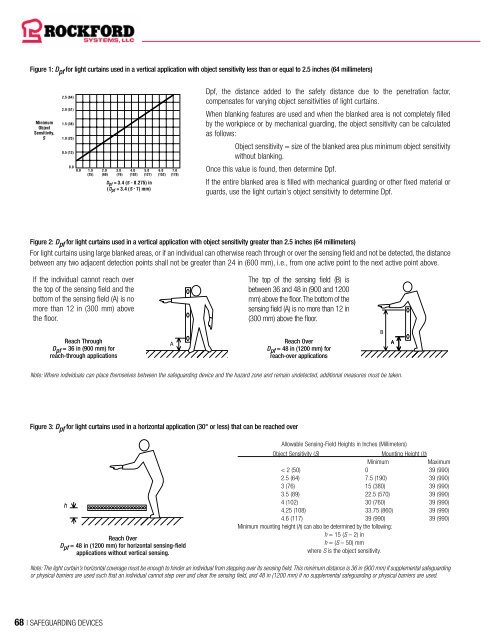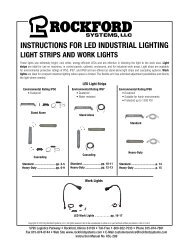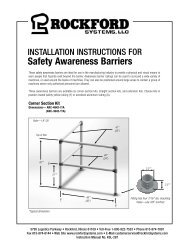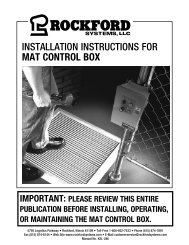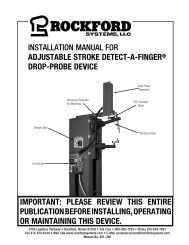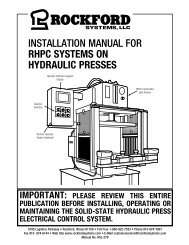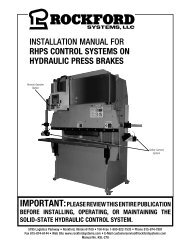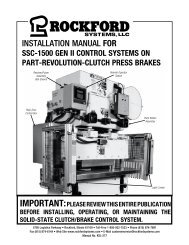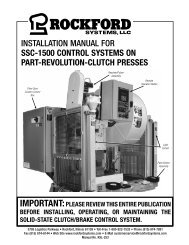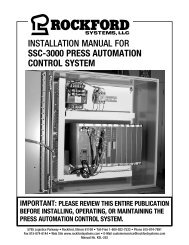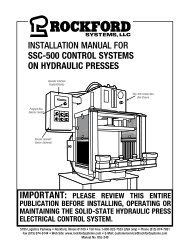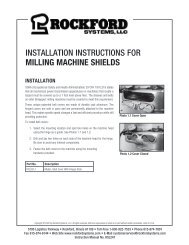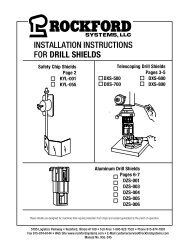Rockford Systems Safeguarding Devices Catalog
FREE, 80-page full-color catalog that features a wide-range of safeguarding devices and other safety-related products for updating hazardous machinery and processes. These devices are designed for point-of-operation safeguarding as well as for auxiliary guarding and large work-envelope safeguarding. Some of the products in this catalog include presence-sensing devices, area scanning devices, tower light assemblies, Detect-A-Finger® drop-probe devices, and pressure sensitive safety mats. These products can be used to safeguard fabricating machines, metal-cutting machines, material handling equipment, woodworking machines, and more.These safeguarding devices are designed to meet or exceed the OSHA regulations and ANSI standards.
FREE, 80-page full-color catalog that features a wide-range of safeguarding devices and other safety-related products for updating hazardous machinery and processes. These devices are designed for point-of-operation safeguarding as well as for auxiliary guarding and large work-envelope safeguarding. Some of the products in this catalog include presence-sensing devices, area scanning devices, tower light assemblies, Detect-A-Finger® drop-probe devices, and pressure sensitive safety mats. These products can be used to safeguard fabricating machines, metal-cutting machines, material handling equipment, woodworking machines, and more.These safeguarding devices are designed to meet or exceed the OSHA regulations and ANSI standards.
Create successful ePaper yourself
Turn your PDF publications into a flip-book with our unique Google optimized e-Paper software.
REFERENCES<br />
Figure 1: D pf for light curtains used in a vertical application with object sensitivity less than or equal to 2.5 inches (64 millimeters)<br />
Dpf, the distance added to the safety distance due to the penetration factor,<br />
compensates for varying object sensitivities of light curtains.<br />
When blanking features are used and when the blanked area is not completely filled<br />
by the workpiece or by mechanical guarding, the object sensitivity can be calculated<br />
as follows:<br />
Object sensitivity = size of the blanked area plus minimum object sensitivity<br />
without blanking.<br />
Once this value is found, then determine Dpf.<br />
Figure 3: D pf for light curtains used in a horizontal application (30° or less) that can be reached over<br />
Reach Over<br />
D pf = 48 in (1200 mm) for horizontal sensing-field<br />
applications without vertical sensing.<br />
If the entire blanked area is filled with mechanical guarding or other fixed material or<br />
guards, use the light curtain’s object sensitivity to determine Dpf.<br />
Figure 2: D pf for light curtains used in a vertical application with object sensitivity greater than 2.5 inches (64 millimeters)<br />
For light curtains using large blanked areas, or if an individual can otherwise reach through or over the sensing field and not be detected, the distance<br />
between any two adjacent detection points shall not be greater than 24 in (600 mm), i.e., from one active point to the next active point above.<br />
If the individual cannot reach over<br />
the top of the sensing field and the<br />
bottom of the sensing field (A) is no<br />
more than 12 in (300 mm) above<br />
the floor.<br />
Reach Through<br />
D pf = 36 in (900 mm) for<br />
reach-through applications<br />
The top of the sensing field (B) is<br />
between 36 and 48 in (900 and 1200<br />
mm) above the floor. The bottom of the<br />
sensing field (A) is no more than 12 in<br />
(300 mm) above the floor.<br />
Reach Over<br />
D pf = 48 in (1200 mm) for<br />
reach-over applications<br />
Note: Where individuals can place themselves between the safeguarding device and the hazard zone and remain undetected, additional measures must be taken.<br />
Allowable Sensing-Field Heights in Inches (Millimeters)<br />
Object Sensitivity (S)<br />
Mounting Height (h)<br />
Minimum<br />
Maximum<br />
< 2 (50) 0 39 (990)<br />
2.5 (64) 7.5 (190) 39 (990)<br />
3 (76) 15 (380) 39 (990)<br />
3.5 (89) 22.5 (570) 39 (990)<br />
4 (102) 30 (760) 39 (990)<br />
4.25 (108) 33.75 (860) 39 (990)<br />
4.6 (117) 39 (990) 39 (990)<br />
Minimum mounting height (h) can also be determined by the following:<br />
h = 15 (S – 2) in<br />
h = (S – 50) mm<br />
where S is the object sensitivity.<br />
Note: The light curtain’s horizontal coverage must be enough to hinder an individual from stepping over its sensing field. This minimum distance is 36 in (900 mm) if supplemental safeguarding<br />
or physical barriers are used such that an individual cannot step over and clear the sensing field, and 48 in (1200 mm) if no supplemental safeguarding or physical barriers are used.<br />
FUNCTION-TESTING CHECKLIST FOR TWO-HAND CONTROL<br />
DANGER<br />
1. Before turning the machine on, verify that:<br />
This is a generic function-testing checklist. Your two-hand control may have other features that require<br />
different tests. Please refer to your two-hand control installation manual.<br />
Make sure that the two-hand control has been interfaced properly to the machine’s control system to<br />
provide control reliability.<br />
Never place your hands or any part of your body in the hazard area while performing these tests.<br />
Always perform these tests at every setup, operator, and shift change, as well as every time after<br />
maintenance is performed.<br />
a. The hand controls are protected against unintended or inadvertent operation. This is usually done with ring guards or fabricated shields.<br />
(If the hand controls are nonmechanical such as capacitive or optical touch buttons, make sure that only an operator’s hands can<br />
actuate them and not other parts of his or her body.)<br />
b. The hand controls are separated by enough distance or configured to require the use of both hands.<br />
c. The hand controls are fixed in position at the proper safety distance. (See the safety-distance equation below.)<br />
d. Two individual hand controls are provided for each operator that is to be safeguarded by two-hand control. When there are<br />
multiple two-hand control stations, there must be an indicator at each station to indicate whether the station is on or off (usually<br />
accomplished with an indicator light), and the means of turning the station on and off must be supervisable (usually done with a<br />
key-operated selector switch).<br />
2. With the machine on and ready to be cycled in the single-cycle mode of operation, perform the following tests.<br />
a. Actuate both hand controls and keep them actuated. The machine should make one complete cycle<br />
and then it should stop, even though the hand controls are still being actuated.<br />
b. Actuate both hand controls and release them while the machine is still in the hazardous portion of<br />
its cycle. The machine should stop. Both hand controls must be continuously actuated during the<br />
hazardous portion of the cycle.<br />
c. Actuate both hand controls and release only one control during the hazardous portion of the cycle.<br />
The hazardous motion of the machine should stop. Reactuate the hand control that was released.<br />
The machine should not finish the cycle. Repeat this with the other hand control. Again, the<br />
machine should not finish the cycle. Both hand controls must be released and reactuated before<br />
the machine can finish the cycle.<br />
d. If the two-hand control has a concurrent timer: Actuate one hand control, wait until the concurrent time limit has expired, and then<br />
actuate the other hand control. The machine should not cycle. The hand controls must be actuated concurrently within a certain time<br />
limit (usually 0.5 seconds or less) before a machine cycle can be initiated.<br />
e. If the machine is equipped with multiple two-hand control stations, turn off all stations and make sure that the machine does not cycle.<br />
Also perform the above tests at each two-hand control station.<br />
3. If any of these function tests fail, take corrective action before running production. If all tests pass, remove all keys from the selector switches<br />
before running production.<br />
The safety-distance equation for two-hand control from Annex D of ANSI B11.19-2010, Performance Criteria for <strong>Safeguarding</strong>, is as follows:<br />
Ds = K(Ts + Tc + Tr + Tspm)<br />
Where:<br />
Ds = safety distance<br />
K = maximum speed that an individual can approach the hazard (63 inches/second is commonly used)<br />
Ts = stopping time of the machine measured at the final control element<br />
Tc = reaction time of the control system<br />
Tr = reaction time of the two-hand control and its interface<br />
Tspm = additional time allowed for the stopping-performance monitor to compensate for variations in normal stopping time<br />
68 | SAFEGUARDING DEVICES SAFEGUARDING DEVICES | 69


